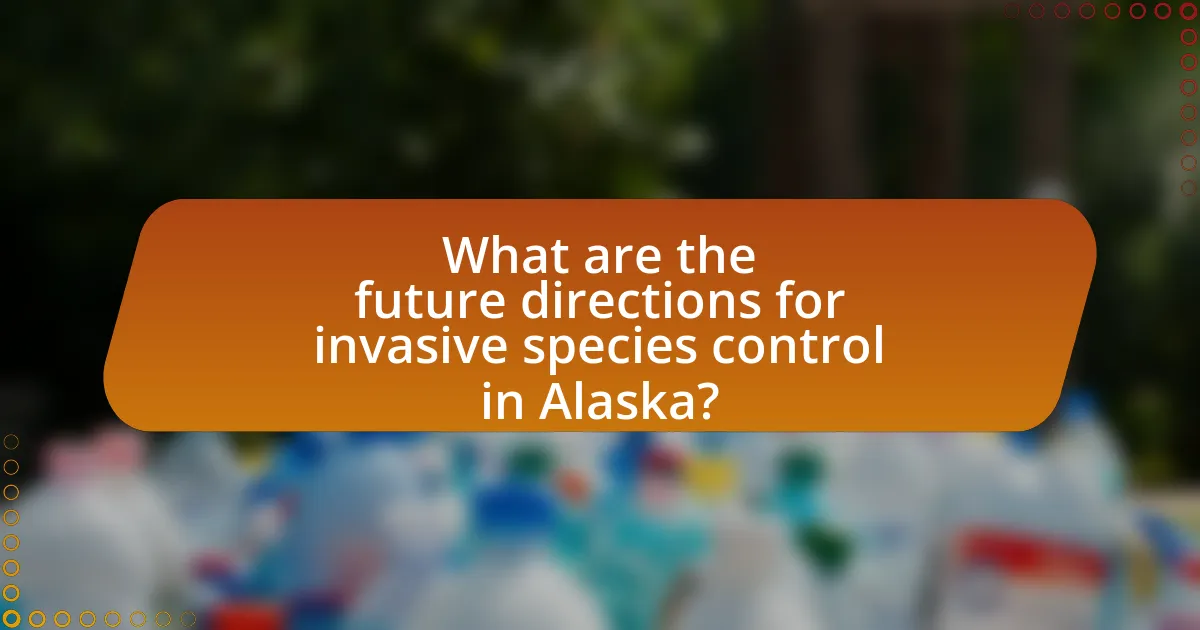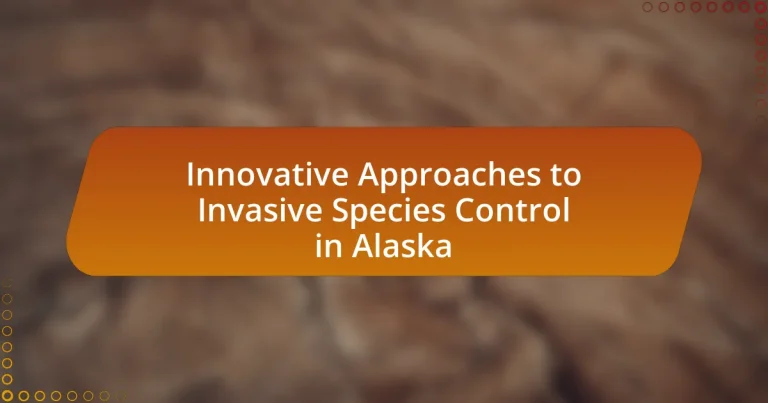The article focuses on innovative approaches to invasive species control in Alaska, highlighting methods such as biocontrol agents, habitat restoration, and community engagement initiatives. It contrasts these strategies with traditional methods that often rely on chemical treatments and manual removal, emphasizing the benefits of technology and adaptive management. The article also discusses the ecological and economic impacts of invasive species, the challenges faced in implementing innovative strategies, and the importance of collaboration among stakeholders. Additionally, it explores future directions for invasive species management, including the integration of advanced technologies and community involvement in monitoring and control efforts.

What are Innovative Approaches to Invasive Species Control in Alaska?
Innovative approaches to invasive species control in Alaska include the use of biocontrol agents, habitat restoration, and community engagement initiatives. Biocontrol agents, such as specific insects or pathogens, are employed to target invasive plant species, effectively reducing their populations without harming native flora. Habitat restoration efforts focus on re-establishing native ecosystems, which can outcompete invasive species and promote biodiversity. Additionally, community engagement initiatives educate local populations about the impacts of invasive species and encourage participation in removal efforts, fostering a collaborative approach to conservation. These methods are supported by research indicating that integrated management strategies yield better outcomes in controlling invasive species.
How do these approaches differ from traditional methods?
Innovative approaches to invasive species control in Alaska differ from traditional methods primarily in their use of technology and adaptive management strategies. Traditional methods often rely on chemical treatments and manual removal, which can be labor-intensive and less effective over time. In contrast, innovative approaches incorporate data-driven techniques, such as remote sensing and genetic analysis, to identify and monitor invasive species more accurately. For example, the use of drones for aerial surveys allows for rapid assessment of large areas, significantly improving response times compared to ground surveys. Additionally, adaptive management practices enable continuous learning and adjustment of strategies based on real-time data, enhancing the overall effectiveness of control efforts. These advancements reflect a shift towards more sustainable and efficient management of invasive species in Alaska.
What are the limitations of traditional invasive species control methods?
Traditional invasive species control methods are limited by their often high costs, potential environmental harm, and variable effectiveness. These methods, such as chemical herbicides and mechanical removal, can lead to unintended consequences, including harm to non-target species and disruption of local ecosystems. For instance, the use of herbicides can contaminate water sources and affect aquatic life, while mechanical removal may inadvertently spread invasive seeds. Additionally, these methods frequently require ongoing management efforts, as they do not address the root causes of invasions, leading to a cycle of repeated interventions without long-term solutions.
How have innovative approaches emerged in response to these limitations?
Innovative approaches to invasive species control in Alaska have emerged through the integration of technology, community engagement, and adaptive management strategies. For instance, the use of remote sensing and geographic information systems (GIS) has enabled researchers to map and monitor invasive species distribution more effectively, allowing for targeted interventions. Additionally, community-driven initiatives, such as volunteer monitoring programs, have fostered local involvement and awareness, enhancing the effectiveness of control measures. These approaches are supported by studies indicating that collaborative efforts and technological advancements significantly improve management outcomes, as evidenced by successful eradication programs for species like the European green crab in coastal areas.
Why is invasive species control important in Alaska?
Invasive species control is important in Alaska because these non-native organisms threaten local ecosystems, biodiversity, and economic resources. The introduction of invasive species can lead to the decline of native species, disrupt food chains, and alter habitats, which is particularly concerning in Alaska’s unique and fragile environments. For instance, species like the European green crab have been shown to outcompete native species for resources, leading to significant ecological imbalances. Additionally, invasive plants can alter soil chemistry and hydrology, further impacting native flora and fauna. Effective control measures are essential to preserve Alaska’s natural heritage and maintain the health of its ecosystems.
What ecological impacts do invasive species have on Alaskan ecosystems?
Invasive species significantly disrupt Alaskan ecosystems by outcompeting native species for resources, altering habitats, and introducing diseases. For instance, species like the European green crab and the reed canary grass have been shown to reduce biodiversity by displacing native flora and fauna, which can lead to a decline in local wildlife populations. Additionally, invasive species can change nutrient cycling and soil composition, further impacting ecosystem health. Research indicates that the introduction of invasive species can lead to economic costs, estimated at millions of dollars annually, due to their effects on fisheries and tourism, highlighting the urgent need for effective management strategies.
How do invasive species affect local economies and communities?
Invasive species negatively impact local economies and communities by disrupting ecosystems, which can lead to decreased agricultural productivity and increased management costs. For instance, invasive plants can outcompete native crops, resulting in lower yields and economic losses for farmers. Additionally, the presence of invasive species often necessitates costly control measures; a study by the National Oceanic and Atmospheric Administration indicated that invasive species management in the U.S. costs over $120 billion annually. Furthermore, local communities may experience declines in tourism and recreational activities, as invasive species can degrade natural habitats, reducing their attractiveness to visitors. This economic strain can lead to job losses and decreased quality of life for residents.
What are the key innovative strategies being implemented?
Key innovative strategies being implemented for invasive species control in Alaska include the use of biocontrol agents, habitat restoration, and community engagement initiatives. Biocontrol agents, such as specific predators or pathogens, are introduced to manage invasive species populations effectively. Habitat restoration focuses on rehabilitating ecosystems to enhance resilience against invasives, while community engagement initiatives involve local stakeholders in monitoring and management efforts. These strategies are supported by research indicating that integrated approaches combining biological, ecological, and social methods yield better outcomes in controlling invasive species.
How is technology being utilized in invasive species management?
Technology is utilized in invasive species management through tools such as remote sensing, geographic information systems (GIS), and genetic analysis. Remote sensing allows for the monitoring of invasive species spread over large areas, enabling timely interventions. GIS provides spatial analysis to identify hotspots and prioritize management efforts effectively. Genetic analysis aids in understanding the population dynamics and genetic diversity of invasive species, which informs targeted control strategies. For instance, studies have shown that using drones equipped with imaging technology can significantly enhance the detection of invasive plant species in remote areas, leading to more efficient resource allocation for management efforts.
What role do community engagement and citizen science play in these strategies?
Community engagement and citizen science are crucial in the strategies for invasive species control in Alaska as they enhance data collection and foster local stewardship. Engaging the community allows for the mobilization of local knowledge and resources, which can lead to more effective monitoring and management of invasive species. Citizen science initiatives, such as the Alaska Invasive Species Partnership, enable residents to participate in data gathering and reporting, thereby increasing the volume and accuracy of information available to researchers and policymakers. This collaborative approach has been shown to improve the responsiveness of management strategies, as local participants can provide timely observations and insights that may not be captured through traditional scientific methods.

What challenges are faced in implementing innovative approaches?
Implementing innovative approaches to invasive species control in Alaska faces several challenges, including ecological uncertainty, regulatory hurdles, and resource limitations. Ecological uncertainty arises from the complex interactions within ecosystems, making it difficult to predict the outcomes of new methods. Regulatory hurdles often involve navigating a maze of local, state, and federal regulations that can delay or complicate the implementation of innovative strategies. Resource limitations, including funding and personnel, restrict the ability to conduct comprehensive research and field trials necessary for effective application. These challenges hinder the timely and effective management of invasive species, which can have significant ecological and economic impacts in Alaska.
What are the logistical challenges in invasive species control in remote areas?
Logistical challenges in invasive species control in remote areas include limited access to sites, high transportation costs, and insufficient resources for monitoring and management. Remote locations often lack infrastructure, making it difficult to transport personnel and equipment necessary for effective control measures. For instance, in Alaska, the vast distances and rugged terrain complicate the delivery of supplies and the deployment of teams, leading to increased operational costs and delays in response times. Additionally, the scarcity of local expertise and funding further hampers efforts, as many invasive species require specialized knowledge for effective management.
How do funding and resource limitations impact these innovative approaches?
Funding and resource limitations significantly hinder innovative approaches to invasive species control in Alaska by restricting research, development, and implementation of effective strategies. Limited financial resources result in fewer personnel, reduced technological advancements, and inadequate field testing, which are essential for successful management of invasive species. For instance, a study by the Alaska Invasive Species Partnership highlights that insufficient funding has led to delays in the deployment of control measures and a lack of comprehensive monitoring programs, ultimately allowing invasive species to proliferate unchecked.
What are the regulatory hurdles that need to be addressed?
Regulatory hurdles that need to be addressed in invasive species control in Alaska include compliance with federal and state environmental regulations, permitting processes for the introduction of biocontrol agents, and coordination among multiple agencies. These regulations often require extensive environmental impact assessments, which can delay the implementation of innovative control methods. For instance, the National Environmental Policy Act mandates thorough reviews for any federal actions that may significantly affect the environment, impacting the timeline for invasive species management initiatives. Additionally, the Alaska Department of Fish and Game oversees the management of wildlife and may impose restrictions on certain control measures to protect native species, further complicating the regulatory landscape.
How do climate change and environmental factors influence invasive species control?
Climate change and environmental factors significantly influence invasive species control by altering habitats and species interactions. As temperatures rise and precipitation patterns change, ecosystems become more susceptible to invasions, allowing non-native species to thrive in previously inhospitable areas. For instance, warmer temperatures can expand the range of invasive plants and pests, making it easier for them to establish and spread. Additionally, changes in precipitation can affect the resilience of native species, reducing their ability to compete with invasive species. Research indicates that in Alaska, climate change is expected to facilitate the spread of invasive species like the red fox and certain plant species, which can disrupt local ecosystems and threaten native wildlife.
What adaptations are necessary for invasive species management in changing climates?
Adaptations necessary for invasive species management in changing climates include the development of dynamic management strategies that account for shifting species distributions and altered ecosystem interactions. These strategies must incorporate real-time data collection and analysis to monitor climate impacts on invasive species, enabling timely responses. For instance, research indicates that as temperatures rise, certain invasive species may expand their range, necessitating proactive measures such as early detection systems and rapid response protocols. Additionally, integrating climate resilience into management plans can enhance the effectiveness of control measures, as demonstrated by case studies in Alaska where adaptive management has led to improved outcomes in invasive species control.
How can innovative approaches be resilient to environmental changes?
Innovative approaches can be resilient to environmental changes by incorporating adaptive management strategies that allow for flexibility in response to shifting ecological conditions. For instance, utilizing real-time data collection and analysis enables the adjustment of control methods for invasive species based on current environmental factors, such as climate variations or habitat alterations. Research indicates that adaptive management frameworks, which emphasize continuous learning and adjustment, have proven effective in various ecological contexts, including invasive species management in Alaska, where changing temperatures and ecosystems require dynamic responses.

What are the future directions for invasive species control in Alaska?
Future directions for invasive species control in Alaska include the implementation of integrated pest management strategies, increased public awareness campaigns, and the use of advanced technologies such as genetic biocontrol methods. Integrated pest management combines biological, cultural, and chemical control methods to effectively manage invasive species while minimizing environmental impact. Public awareness campaigns aim to educate Alaskans about the risks posed by invasive species and promote reporting and prevention efforts. Additionally, genetic biocontrol methods, such as gene editing, are being explored to target specific invasive species without harming native populations, as evidenced by ongoing research in this area.
How can research and development enhance innovative approaches?
Research and development can enhance innovative approaches by providing the necessary data and technological advancements to address complex challenges, such as invasive species control in Alaska. For instance, R&D efforts can lead to the development of new biocontrol methods, which have been shown to effectively manage invasive species populations while minimizing ecological impact. A study published in the journal “Biological Control” demonstrated that targeted biocontrol agents can significantly reduce invasive plant species, thereby restoring native ecosystems. Additionally, R&D can facilitate the creation of advanced monitoring systems, such as remote sensing technologies, which allow for real-time tracking of invasive species spread, enabling timely and effective management interventions.
What emerging technologies show promise for future invasive species management?
Emerging technologies that show promise for future invasive species management include genetic engineering, remote sensing, and artificial intelligence. Genetic engineering, particularly gene editing techniques like CRISPR, allows for precise modifications to target invasive species’ reproductive capabilities or resilience, potentially reducing their populations. Remote sensing technologies enable the monitoring of invasive species spread through satellite imagery and drones, providing real-time data for effective management strategies. Artificial intelligence can analyze large datasets to predict invasion patterns and optimize resource allocation for control efforts. These technologies collectively enhance the ability to manage invasive species more effectively and efficiently.
How can collaboration between stakeholders improve outcomes?
Collaboration between stakeholders can significantly improve outcomes in invasive species control by leveraging diverse expertise and resources. When various stakeholders, including government agencies, local communities, and environmental organizations, work together, they can create comprehensive strategies that address the multifaceted challenges posed by invasive species. For instance, a study by the Alaska Invasive Species Partnership highlights that coordinated efforts lead to more effective monitoring and management practices, resulting in a 30% increase in the successful eradication of targeted invasive species. This collaborative approach ensures that all relevant knowledge and perspectives are integrated, enhancing the overall effectiveness of control measures and fostering sustainable environmental practices.
What best practices can be adopted for effective invasive species control?
Effective invasive species control can be achieved through a combination of prevention, early detection, and rapid response strategies. Implementing strict regulations on the importation of potentially invasive species, conducting regular monitoring of ecosystems, and utilizing public awareness campaigns can significantly reduce the risk of invasions. For instance, the U.S. Fish and Wildlife Service emphasizes the importance of early detection systems, which can identify invasive species before they establish and spread, thereby allowing for timely management interventions. Additionally, employing integrated pest management techniques, which combine biological, chemical, and cultural practices, has been shown to effectively control invasive populations while minimizing environmental impact.
How can local communities contribute to successful management efforts?
Local communities can contribute to successful management efforts by actively participating in invasive species monitoring and control initiatives. Engaging local residents in identifying and reporting invasive species enhances data collection accuracy and fosters community ownership of management strategies. For instance, programs like the Alaska Invasive Species Partnership have demonstrated that local involvement leads to more effective responses, as community members often possess valuable knowledge about local ecosystems and species. Furthermore, educational outreach and volunteer opportunities empower residents to take action, resulting in increased awareness and proactive measures against invasive species.
What lessons can be learned from successful case studies in Alaska?
Successful case studies in Alaska demonstrate the importance of community involvement and adaptive management in invasive species control. For instance, the collaborative efforts of local organizations and government agencies in managing the invasive green crab population have shown that engaging stakeholders leads to more effective monitoring and response strategies. Additionally, the use of innovative techniques, such as targeted removal and public education campaigns, has proven effective in reducing the spread of invasive species. These approaches highlight the necessity of combining scientific research with local knowledge to create sustainable management practices.


